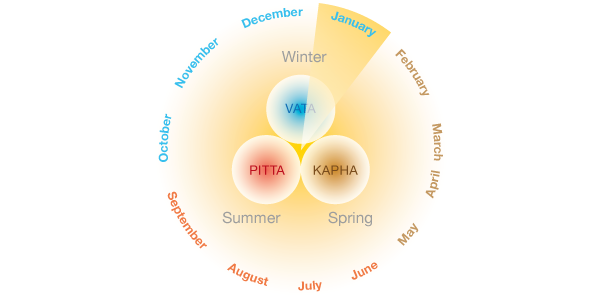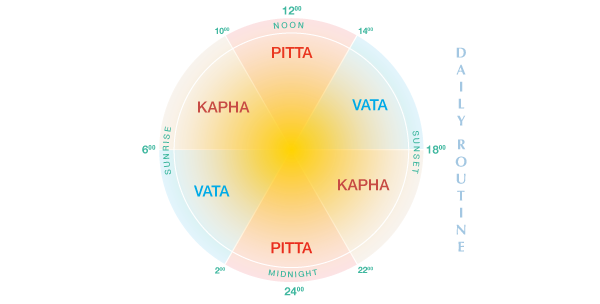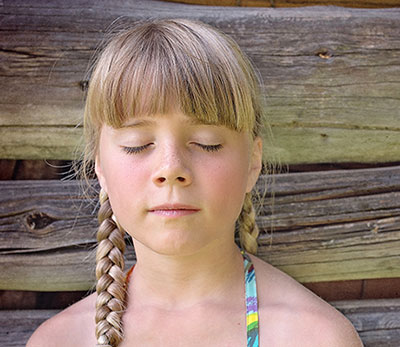Each season affects the three Doshas in its own way. In ancient Ayurvedic texts, the year is divided into 6 seasons. In Europe, we are used to 4 seasons, with warm/dry and cool/humid periods. If we adapt the Ayurvedic concept to European climatic conditions, we get approximately the following picture:
| • February, March, April, May | Kapha period |
| • June, July, August, September | Pitta period |
| • October, November, December, January | Vata period |

Since our seasons are quite variable, this can only be a rough approximation. Depending on the weather conditions, the given time periods can easily shift weeks forward or backward.
Winter is generally characterized by cold and very changeable weather, sometimes dry, sometimes rainy and wet. These characteristics are attributed to Vata and Kapha Doshas. At the beginning of winter, Vata characteristics tend to predominate, while Kapha becomes more prevalent in the second half of winter. Therefore, during the cold season, people with a Vata or Kapha constitution should take extra good care of themselves.
People with Kapha predominance are more prone to respiratory and digestive problems, while those with Vata predominance tend to feel off-balance, especially when the weather is cold and windy.
People with a stronger Pitta component, on the other hand, generally find a lower temperature pleasant: they sleep better, their mind is clearer and they tend to be less irritable.
Dakshinayan – the course of the sun from the viewpoint of Ayurveda
In summer, more precisely on June 21, the sun reaches its northernmost position. From then, it moves south until it reaches its southernmost point on December 21, after which it starts moving in a northerly direction again. Dakshinayan is that half of the year when the sun moves south and its radiance decreases (in European latitudes). At the same time, the cooling radiance from the moon and the water element increase. This also affects us, in that the body cells retain more water. Kapha Dosha is composed of the elements water and earth.
As a rule, the transitions from one season to the next are gradual, giving the physiology enough time to adapt. Nevertheless, accumulation of Doshas is commonly observed and to be expected in times of climatic change. Initially, accumulation does not lead to illness, but rather to non-specific symptoms, such as fatigue, sluggishness of the bowels, or restless sleep. On the ground of such imbalances, secondary diseases can develop more easily, e.g. infections, because the immune system is weaker than usual.
An Ayurvedic principle:
A Dosha which increases during one season creates imbalance during the next.
To avoid this negative influence, Ayurveda recommends balancing accumulated Doshas during the transition to the next season.
Thus, in winter, too much Vata can cause difficulties and symptoms. You can prevent an increased susceptibility to illness as follows:
- Prefer Vata-pacifying foods, i.e. relatively liquid, warm and oily. In winter, the physiology can metabolize more fat, for example in the form of high-quality Ghee, as long as the amount is adapted to your individual digestive power.
- Particularly suitable are the flavors sweet, sour and salty.
- A regular daily routine in terms of one’s sleep patterns and meal times is very Vata-pacifying.
- As often as time permits, give yourself a nourishing full-body oil massage (Abhyanga) before showering. Oil is a wonderful antidote for too much Vata Dosha and also nourishes the skin in a very natural way. A very suitable oil is cured sesame oil.
- Vata-increasing substances such as coffee, black tea, and cold drinks should be avoided when possible.
- Instead, warming herbal tea and hot water are ideal. If you struggle with digestive problems such as flatulence and bloating, boil the water with a few spices: a little ginger, cumin, coriander and fennel seeds. This makes for a great taste and gently enhances intestinal activity.

How to protect yourself effectively during winter
When temperatures continue to fall, our physiology counteracts by ramping up the digestive fire (Agni): it tries to adjust to the external conditions by producing more warmth. Somewhat like when we use a poker to stoke up a fire, our body stimulates the metabolism.
This is where food intake plays a big role. On the one hand, it is important to eat nutrient-rich food, so that your Agni does not begin to eat away at the body tissues (Dhatus). On the other hand, the food should not be so heavy that your individual digestive power becomes overloaded and weakened. It is precisely when Agni is out of balance that illnesses can arise, and in winter especially colds.
Respiratory infections are usually a sign of accumulated Kapha, especially if they are persistent and accompanied by viscous mucus.
Therefore, in winter, refrain from:
- too much snacking, which weakens the Agni
- too much of pastries and sweets
- heavy food in the evening (e.g. greasy or with animal proteins)
- food and drinks straight from the refrigerator
- daytime sleep longer than 30 minutes
- lack of physical activity
The above points are all Kapha-increasing factors that can lead to susceptibility to infections and lethargy.
Other tips for the cold days
Winter time doesn’t just bring problems – it’s a great time for going inward, for reflecting on days past and imagining what may lie ahead.
To quieten the mind, meditation is probably the best-known tool.

By now, the healing effect of meditation has been scientifically researched very well. A special role is played by the parasympathetic nervous system, which is activated by meditation – one of the basic prerequisites for healing processes. Studies show particularly impressive results with the Transcendental Meditation technique, which you can also learn during a spa retreat in Bad Ems.
In the Maharishi Ayurveda Health Centre Bad Ems, you can improve your own health in a holistic way.

The tranquil little town of Bad Ems is located in Rhineland-Palatinate, on both sides of the Lahn River. Famous since centuries for its healing thermal springs and architectural beauty, the state-approved health resort has already inspired Russian tsars, Kaiser Wilhelm I, Johann Wolfgang von Goethe, Fyodor Dostoyevsky and Franz Liszt. Our award-winning Health Centre for Ayurvedic medicine is located in the Emperor wing of Häcker’s Grand Hotel, a historic building, yet with all modern comforts.
Taking short breaks at home
If a course of treatment is not currently possible, you can still benefit greatly from a regular break at home. For example, you could reserve one day a week just for you and your needs, when you might enjoy the following:
- Listening to Gandharva Veda music
- Taking a long walk
- Using balancing essential oils, such as rose or lavender, either in a diffuser or for body care
- A full-body oil massage followed by a warm tub bath
- Trying out a new Ayurvedic recipe. Tip: browse the recipes on our website or use the search function.
- Highly recommended during winter are yoga and breathing exercises, especially the invigorating Sun Salutation and Pranayama (breathing exercises). Also, a slow Yin Yoga session can be wonderfully grounding when your Vata Dosha and inner turmoil are running high.
- Meditations and affirmations.
As you can see, there are many ways to take good care of yourself and use the cold, gray winterdays to recharge energetically and enter the new year even stronger. Just give it a try!
© Maharishi AyurVeda Privatklinik Bad Ems
I have been wanting to see the proper instructions for a good seasonal routine during the winter months, these points are very helpful and seem very simple to follow. Thank you so much for this information. All the best this coming year.